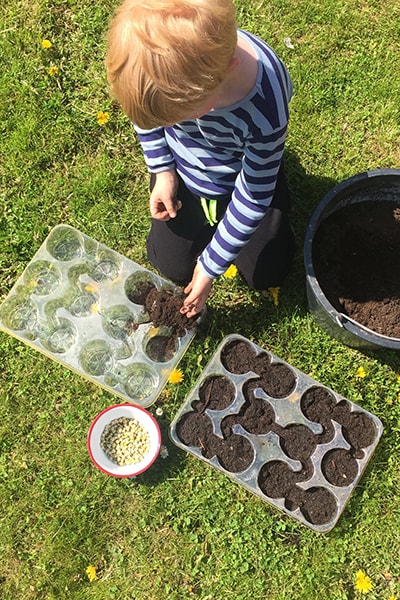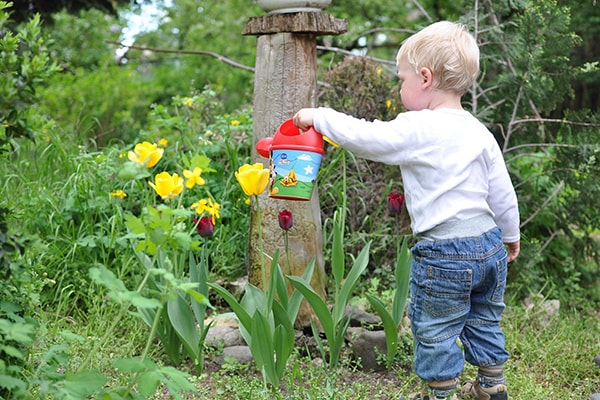
We all know how important it is to get children into gardening – they spend time outside getting active, learn about nature and sustainability, and find out where their food comes from and how it affects their health.
But we also know that getting kids involved can be difficult. They have short attention spans, can be impatient for results and find it more difficult than adults to deal with failure.
Bearing all this in mind, we think that it’s useful to approach children’s gardening as a series of projects, designed to spark their interest and ensure that they see the fruits of their labour, with all the satisfaction this brings.
Whether you’re a parent or teacher, you’ll find that having a plan for your children’s gardening activities, at home or at school, will make the whole experience a lot more fun for everyone.
Some Great Starter Projects
Grow their own food
What better way to start than by introducing children to the idea that they can make the food that they eat?
Of course, it’s important to give them a sense of success, so it’s vital you pick foods that are easy to grow, or interesting to see and feel.
Some quick options, recommended by the Royal Horticultural Society, include the Swiss chard variety called ‘Bright Lights’, radishes, lettuces, courgettes and runner beans. Or you can try edible flowers like nasturtiums and daylilies.
Grow plants and flowers
If the way to your kids' hearts isn't through their stomachs, try appealing to them visually. For a seed-planting project, try sunflowers, marigolds and poppies.
Next time, think about plants that have some unusual qualities, like rattling poppyseed heads; plants with strong smells, such as a curry plant, lemon balm, and chocolate cosmos; or plants that are interesting to touch, like furry Stachys byzantina.
You can also arrange seeds into shapes, for example the children’s initials, so that when they flower the children can see the shapes come to life.
Give them their own patch
Children who take responsibility for their own patch of garden will be especially proud of their results.
At home, consider using raised beds so that they have a self-contained area to use.
If you have a small garden space, perhaps you might consider an allotment? This would offer your children more scope for roaming around, as well as the opportunity to compare contrasting plots.
At school, teachers could get the children to make hanging baskets out of old mugs, tins or even wellies.
Build some garden structures
Schools might have space for a greenhouse made of bottles, or some large raised beds in the playground. Making a compost heap is another great garden project. Or make a wormery, a creepy-crawly cubbyhole or an insect hotel. Perhaps stack old wooden pallets, slot some drain pipes or bamboo canes between them, then stuff them with bits of wood, fallen leaves and other garden debris?
At home, you can make a simple wormery out of a large glass jar, some vegetable peelings, leaves and some earthworms.
Of course, painting or personalising the structure is not just a fun way to get creative, it promotes a real sense of ownership too.
Take them on an adventure
Just as you need seeds to make a harvest, you need to plant a seed to spark a child's interest.
How about a trip to a local garden centre, where the children get to pick exactly what they'd like to grow?
Or maybe a field trip to introduce them to nature, but on a grander scale? Visit The National Trust website for some great ideas.

Tips for Planning A Project for Kids Gardening
The main reason for planning the project is to allow the children to understand the point of what they are doing, and give them a sense of anticipation of what the end result might be – all very useful for keeping them motivated.
- Start by introducing the project – perhaps tell them a story about how plants grow and maybe use a children’s picture book to help.
- While you’re gardening, try to take some before and after pictures. This will be useful later on, so they can see just how much work they’ve done.
- Get them to make a record of exactly what they did, like how many seeds were planted, where they were planted, the type and the date.
- At the end, pull together all the information about what you’ve done and maybe display it as a poster – younger kids will enjoy cutting out and sticking on pictures, while older ones might be able to use their computer skills.
Spending time in the garden is vital to a child's development, but don’t forget that the main point is to have fun - watching the joy of gardening grow inside your children will be hugely rewarding. Soon, they’ll be the ones coming up with ideas for new gardening projects.




